Easy to say, not exactly easy to do. We saved Kakadu National park for the very last part of our Australian adventure. It was the furthest out we could get in Australia and with our interest in native art in general and Aboriginal art in particular no other state could offer more than Northern Territory. So we decided to fly to the capital, Darwin despite the height of the monsoon season. After battling record floods in Queensland for the last few days, we figured it couldn’t be much worse.
 Split Rock art near Laura, Queensland
Split Rock art near Laura, Queensland
On our way up through Australian East Coast we took every opportunity to learn and dig for information on this art and people behind it. Still, we only scratched the surface. General population does not seem to be highly interested in Aborigines or their art, no matter how politically incorrect this statement sounds. In cases when trying to be helpful, information on the rock art, location or access were not very reliable to say the least, qualified by seasonal factors as they are located in tropics. We stopped at every gallery we could find, but talking to dealers did not get us anywhere, as they seemed to want to protect their lucrative market sources, even as they seemed friendly in some cases, or openly less than friendly in some.
And Australian travel industry is a special chapter of its own. It looks like it is directed more towards mass tourism with pre-packaged tours and individual travelers like us are not very high on their priority list. To be honest we, as a couple are not very keen and adaptable to travel in large groups and let the “collectivist” nature of this industry mold our individualistic preferences related to how, when, where and with whom. The bathroom breaks for two are complicated enough, let alone waiting for thirty to go. Just as with food and booze in Australia, we found that the group tours very extremely expensive. They must pay those bus drivers and tour guides top dollars. Then, there is a certain peculiarity related to Australian life style that also impacts travel services. Aussies, otherwise very cheerful, pleasant and helpful people, with their rather casual approach and high quality life style would rarely go an extra mile when in service, especially if they are not business owners, but employees only. And if you come to them outside of their paid working hours, you are on your own.
For example, when we burst through the door of the Darwin Information Center drenched in sweat from the short jog in 100% humidity ten minutes before the end of business hours at 3 pm on Saturday, we first had to climb over a chair placed inside the door. It was not there to catch the poor collapsing tourist, but to give a clear message and place an obstacle. Hopefully the bloody tourist will break a leg and an ambulance will take him away before he reaches the counter. After you manage to get over this first line of defense into a huge, cavernous and totally empty space (with freezing air conditioning- maybe the poor sweaty sod will get a stroke or at least a pneumonia) be prepared to face the “welcoming committee”. Seeing our chair climbing success the government tourist worker launched herself with astounding agility and intercepted us halfway, preventing us from getting even and inch closer to the info desk with introductory remarks,
“We are closing in exactly two minutes. So do not expect more than an answer to one simple question!” No kidding!
At the reception desk of one of the well known galleries of aboriginal arts where we inquired on location and accessibility of rock paintings or seeing indigenous artists at work, we got the following recommendation:
“You know what, it would be better if you drive ther(about 200 miles away) and ask there what you can see and if they are accessible. They should know better! And by the way our art collection is probably much better! Or try the museum.”
So we followed the advice and drove to the Museum and Art Gallery of the Northern Territory. With a few hours still safely before the closing time we were welcomed kindly and informed that all the Aboriginal art galleries in the museum have been closed for renovation, but we were welcome to see the cyclone exhibits for free. If we really insist on art there is an old catalog available in the gift store for 50 bucks.

So we drove to the Kakadu National park 3.5 hours away and stopped at the Visitor’s center. After wandering around for 20 minutes in the deserted halls and gifts center we finally found a khaki clad guy, whose first concern was—Did we purchase the 7 day National park pass yet?
“No, we didn’t and we only plan to stay two days.”
“There are no 2 day passes. But this pass gives you the right to walk in the park and use any of the tours.”
“You mean free ranger tours?”
“Oh, no, we have no free ranger tours now, we are out of the season.”
“OK, then, are there any paid guided tours available? We are very interested in the rock art.”
“Um, yes, there is one, but they only go on Wednesdays and Sundays.”
“Oh, good, lucky us. It is Sunday today.”
“Ya, well, that tour already left. You can wait till Wednesday, you have just purchased a 7 day pass.”
We then spot a poster advertising sightseeing flights. Our eyes light up.
“Are there any sightseeing flights in the area? We are very interested in taking one of them today or tomorrow.”
“I don’t know when they fly but here is their brochure.”
“Sorry, sir, but there is no detailed information here. “
“You are just going to have to call them then,” he suggested.
“There is no phone number listed…”
Reluctantly he then walked to the back and after awhile returned with the number on a yellow sticky pad. We tried dialing it a few times with no success.
“Sorry, sir, but this is an Australian 800 number and our US cell phone would not connect. Would you be so kind to call them? We will take any flight, any time for any price!”
He turned back to the inner office sanctum and came back with another yellow sticky pad. On it was a magic number— 2:30.
“Nothing today. There might be a flight tomorrow at 2:30 in the afternoon, but you have to call them today at 4:30 to check with them again.”
In spite of those obstacles, and thanks to the dogged perseverance of my fellow traveler and wife, we succeeded and saw more than you would have guessed and those two days made Australia such an extra great place to visit.
Kakadu National Park was established only in the late 1970. Wikipedia informs us that it is the the size of Slovenija or half of Switzerland and there are only two sealed roads to take you in: The Arnhem Highway from Darwin and Kakadu Highway from Australian interior, the rest are 4W drive tracks, often flooded.
 When we left Darwin on a surprisingly sunny Sunday morning in our little Kia we did not know much, but we had high hopes and a full tank. We learned our lesson when we nearly got stranded looking for the above depicted less well known rock paintings in Laura, Queensland. We limped into a one-handle-only pump station with the empty tank screaming in alarm.
When we left Darwin on a surprisingly sunny Sunday morning in our little Kia we did not know much, but we had high hopes and a full tank. We learned our lesson when we nearly got stranded looking for the above depicted less well known rock paintings in Laura, Queensland. We limped into a one-handle-only pump station with the empty tank screaming in alarm.
 As we turned on the Arnhem Highway we saw what we were going to face. A vast wetland of the Alligator Rivers swollen by monsoons of rainy season, not another car in sight. Why Alligator Rivers? Well, the English gentleman who first mapped the Northern Territory shoreline noticed that the mouths of the river estuaries were infested by animals looking like alligators he saw shortly before on another assignment in Florida. And the mistake was born. Instead of Crocodile River, he named it Alligator River and as he discovered multiple versions of the one, he conveniently named them South, East and West Alligator Rivers! Not very innovative and wrong, but it stuck for good!
As we turned on the Arnhem Highway we saw what we were going to face. A vast wetland of the Alligator Rivers swollen by monsoons of rainy season, not another car in sight. Why Alligator Rivers? Well, the English gentleman who first mapped the Northern Territory shoreline noticed that the mouths of the river estuaries were infested by animals looking like alligators he saw shortly before on another assignment in Florida. And the mistake was born. Instead of Crocodile River, he named it Alligator River and as he discovered multiple versions of the one, he conveniently named them South, East and West Alligator Rivers! Not very innovative and wrong, but it stuck for good!
So what are we going to do to stay safe from the crocodiles?
Let us make a serious plan and follow it. First, where we can drive, we WILL drive. If we cannot drive any further? Then we WILL walk. If we cannot walk any further? Then we WILL get on a boat. And if we cannot get there by car, by foot or by boat? No problem, my friends! We WILL fly!
 We knew there were three locations with aboriginal rock paintings, but only one could be reached in the middle of the wet season.
We knew there were three locations with aboriginal rock paintings, but only one could be reached in the middle of the wet season.

It is called Nourlangie Rock. And it was worth hiking there despite 100% humidity and 34C (90F) with bloody Aussie flies annoyingly air raiding our sweat soaked bodies. Even as the access to the painted rock outcrops was well signed, not a drop of water nor air-conditioning was provided!!!
Ancient rock art is like modern art. It is open to interpretation. You bring to it your own ideas, you see what you want to see. Some guidance by aboriginal elders is provided, but only some. This may be a creation story, a hunting experience or some other aspect of life. There are many layers from different times painted over. If you were not there when the painting was done, it is hard to know what the story really was. As the traditional owners say: Some rock stories are not for everyone to know, some rock art is sacred and not for everyone to see.
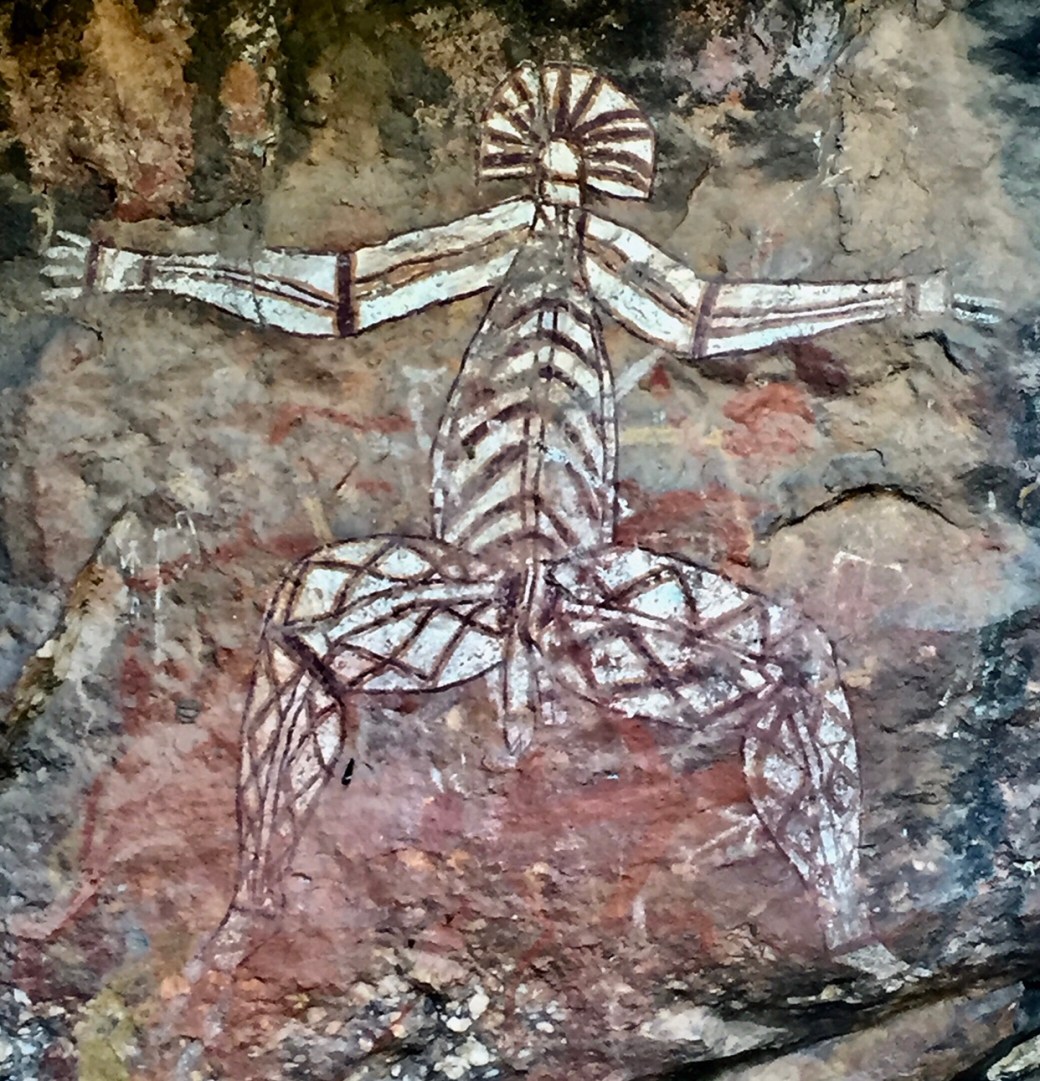
The dangerous spirit Nabulwinjbulwinj who eats females after striking them with a yam. Apparently neither political correctness nor feminism were highly popular among aboriginal artists some five thousand years ago! By the way, pronounce the spirit name Nar-bull-win-bull-win!
Full of artistic impressions and considering the lack of other targets we could walk to, what would be the next item on our plan? If you cannot walk, get on the boat!
We drove a few miles down the Kakadu Highway where Cooinda Lodge lies on the South Alligator River Bank. The decision is made hastily after a short discussion between this expedition participants: Let’s try to get a room and if it works out, they may have a boat to show us the crocodiles of the Alligator River! The fast and shockingly multitasking young South African receptionist helps arrange both in a matter of minutes and we run to catch the nearly empty boat.

She has walkie talked our last minute arrival and as soon as we jump on board we go towards the sunset and the maze of channels, billabongs, swamps and river arms.
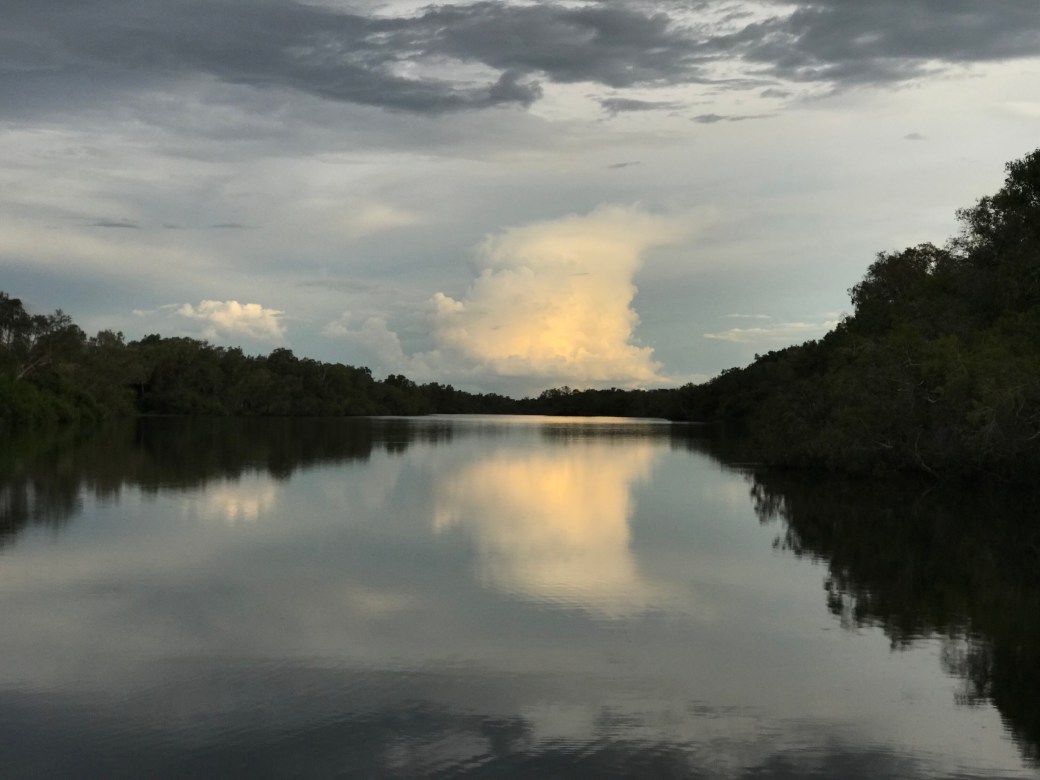 Just beyond the peak of the rainy season the wetland still has plenty of water with waterways lined by paperbark trees
Just beyond the peak of the rainy season the wetland still has plenty of water with waterways lined by paperbark trees
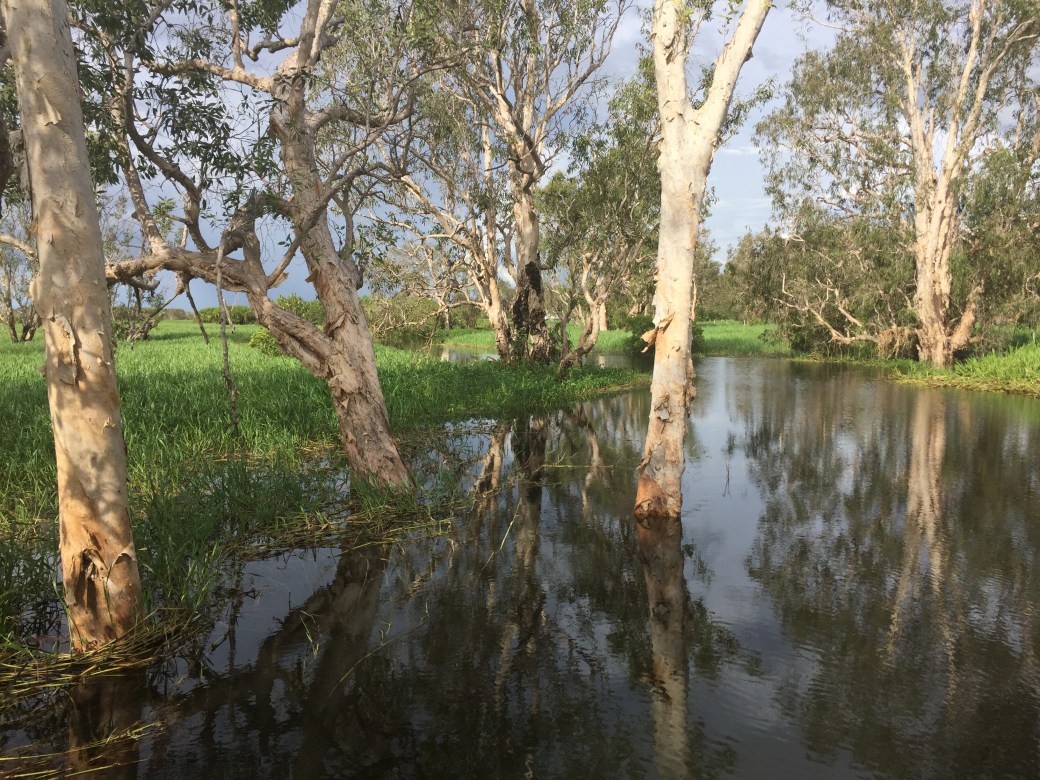 we can occasionally touch with our fingers when we forget the skipper’s warnings not to have any appendages sticking over the edge.
we can occasionally touch with our fingers when we forget the skipper’s warnings not to have any appendages sticking over the edge.
We see the first croc immediately, but he goes under quickly. The next does not leave us waiting for too long. A female by our skipper’s educated guess because of her size of about 2.5m (8-9feet). Male crocs are much larger, on average 4m (13-14feet). It comes with warning not to lean too much over the boat railing as the crocs can jump above the river surface for the full length of their bodies and snap up any part of your body if not all of YOU. This female, contrary to our first crocodile is not shy and cruises around our boat for good ten minutes before we decide to move on and leave her in peace. We are told it is time for the crocks to look for mates.

With the croc off everyone’s bucket list we can enjoy the rest of our ride watching different birds from about 250 species living in wetland, many of them coming from remote places like Siberia, Japan, Korea or China. We are not avid bird watchers, but it is fun to see some unusual ones like glittery kingfishers and especially the fragile looking jacana (called Jesus bird for its ability to walk on the water).
 We find a male jacana taking gentle care of his three mini sized youngsters. When the skipper explains the arrangement that the female jacana has of laying eggs and then letting the male incubate her offspring while she goes off to find another guy and repeat the cycle, one of the young men on the boat jokingly comments, “What a slut!”
We find a male jacana taking gentle care of his three mini sized youngsters. When the skipper explains the arrangement that the female jacana has of laying eggs and then letting the male incubate her offspring while she goes off to find another guy and repeat the cycle, one of the young men on the boat jokingly comments, “What a slut!”
 The evening sky with heavy rain clouds is dramatic and the ride back is pleasant with temperature dropping. While pretty tired after an exciting day we decide on the spot to return back for a sunrise boat ride. And in excitement with our good progress we decide to also book a flight over both wetland and Arnhem Escarpment to see places completely cut off during the rainy season.
The evening sky with heavy rain clouds is dramatic and the ride back is pleasant with temperature dropping. While pretty tired after an exciting day we decide on the spot to return back for a sunrise boat ride. And in excitement with our good progress we decide to also book a flight over both wetland and Arnhem Escarpment to see places completely cut off during the rainy season.
Tropical night comes fast and it is pitch dark night when we finally get into our Room number 9 and drop dead into our beds. Thank you whoever invented air conditioning.
The morning welcomes us with grey overcast skies, splashing some cold water on our yesterday’s feelings of elation, but what the heck, we’ll see. And here we go again. Big white breasted Sea eagles building a nest. “Eat your heart out, National Geographic,” yells our morning skipper. Then a flock of magpie geese, (roasted on hot coals, a delicacy of my Aboriginal family, says the skipper), and white cockatoos and even black ones. A yellow snake, another crocodile, all a bonus for us. The morning sun plays with the clouds, a misty rain falls down and a beautiful rainbow appears over the wild rice expanse. 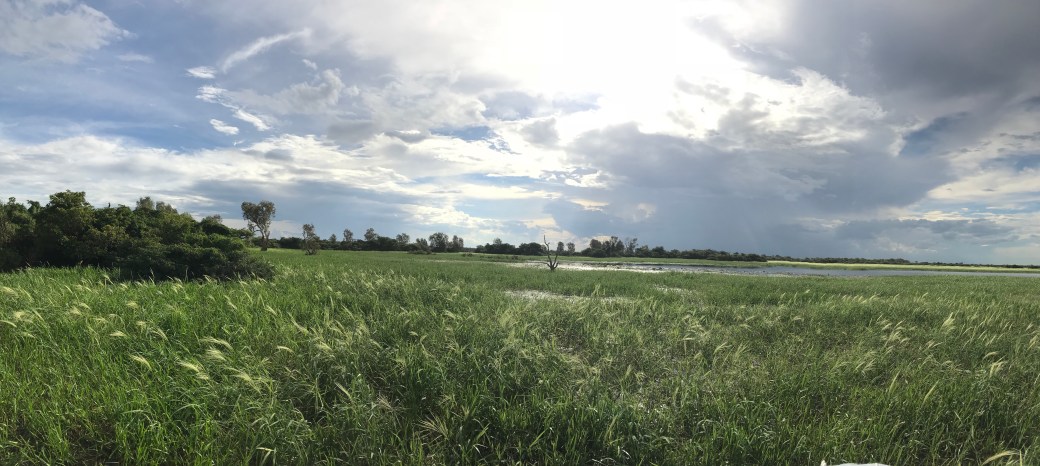 Just before we reach our landing pier the weather gets worse and rain pours on us as we run towards our room.
Just before we reach our landing pier the weather gets worse and rain pours on us as we run towards our room.
Well, nothing lasts forever, specially not in the wetlands! By noon, the sun is back and we optimistically welcome our pilot Jacob as he arrives to the lodge to pick us up bearing more good news. The weather has been improving, and with spotty showers our flight should be very interesting AND we are the only passengers in his 8-seater!!! It may be one hour early but there is nobody to wait for, so we jump into his van for a short ride to the landing strip where his plane waits for us.
 Everything is very informal, he checks only our weight, short introduction about our plane and souvenir bags (called souvenir bags, because if you barf in them, you have to take them home as a souvenir) and we are in the air…
Everything is very informal, he checks only our weight, short introduction about our plane and souvenir bags (called souvenir bags, because if you barf in them, you have to take them home as a souvenir) and we are in the air…
I can hardly believe how short can one hour be! After quick zigzag into elevation safely from the wetlands barely above the sea level our pilot takes us straight to the biggest 4 waterfalls dropping from the Arnhem Land Plateau. He circles 2-3 times over each and they are all spectacular.
 Full of white roaring water tumbling down the magnificent red rocks. A reverse view, instead of craning our necks looking upwards from the base as we have done so often in New Zealand, Tasmania and Queensland, we are now looking down. And they are all ours. The biggest of all, Jim Jim Falls is inaccessible by land till the dry season in the Australian winter (our summer).
Full of white roaring water tumbling down the magnificent red rocks. A reverse view, instead of craning our necks looking upwards from the base as we have done so often in New Zealand, Tasmania and Queensland, we are now looking down. And they are all ours. The biggest of all, Jim Jim Falls is inaccessible by land till the dry season in the Australian winter (our summer).
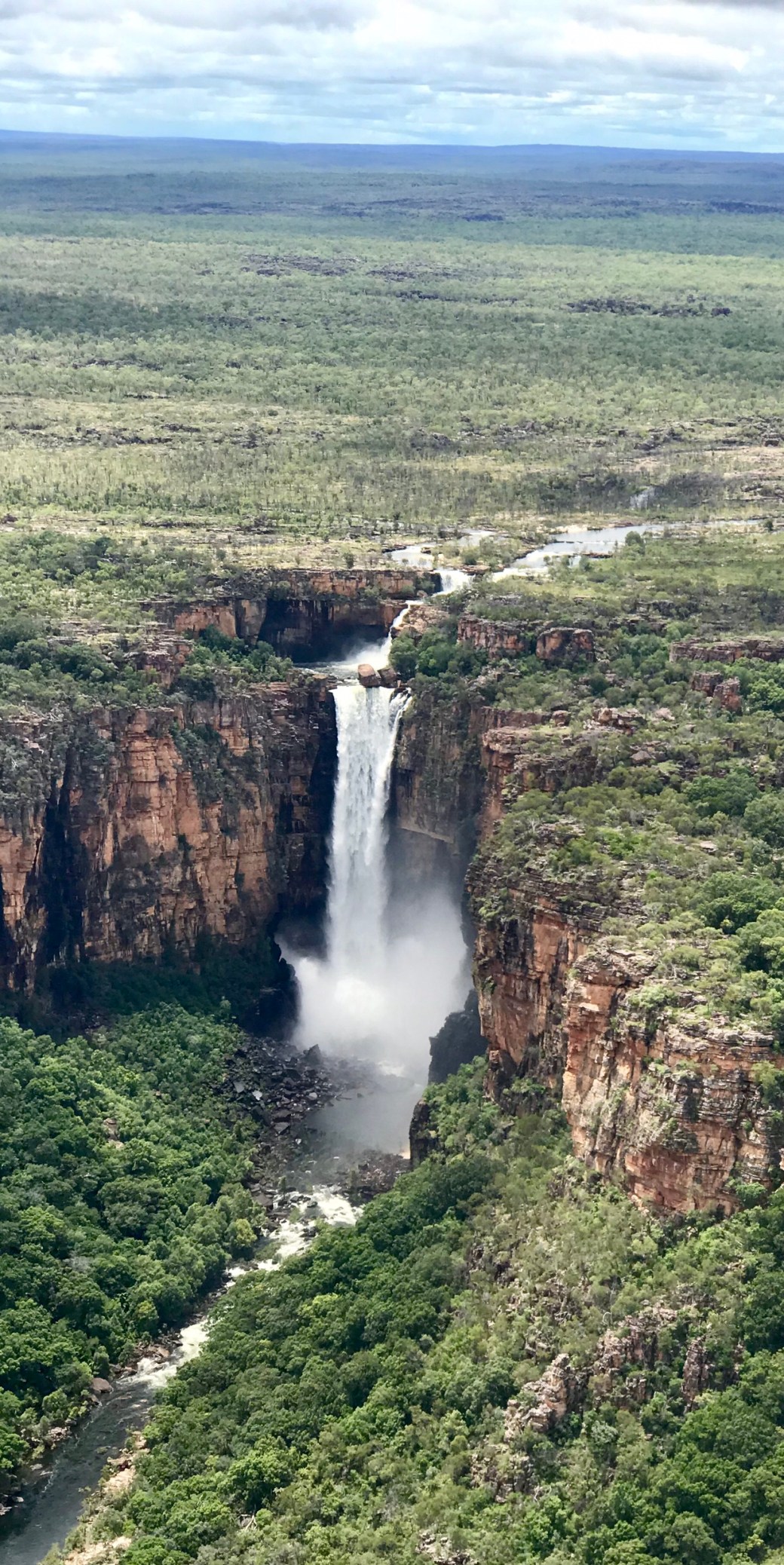
After the completion of the waterfall presentation for the remaining 15 minutes we get a beautiful flight over the green and blue wetlands that we had explored on the boat just a few hours earlier.
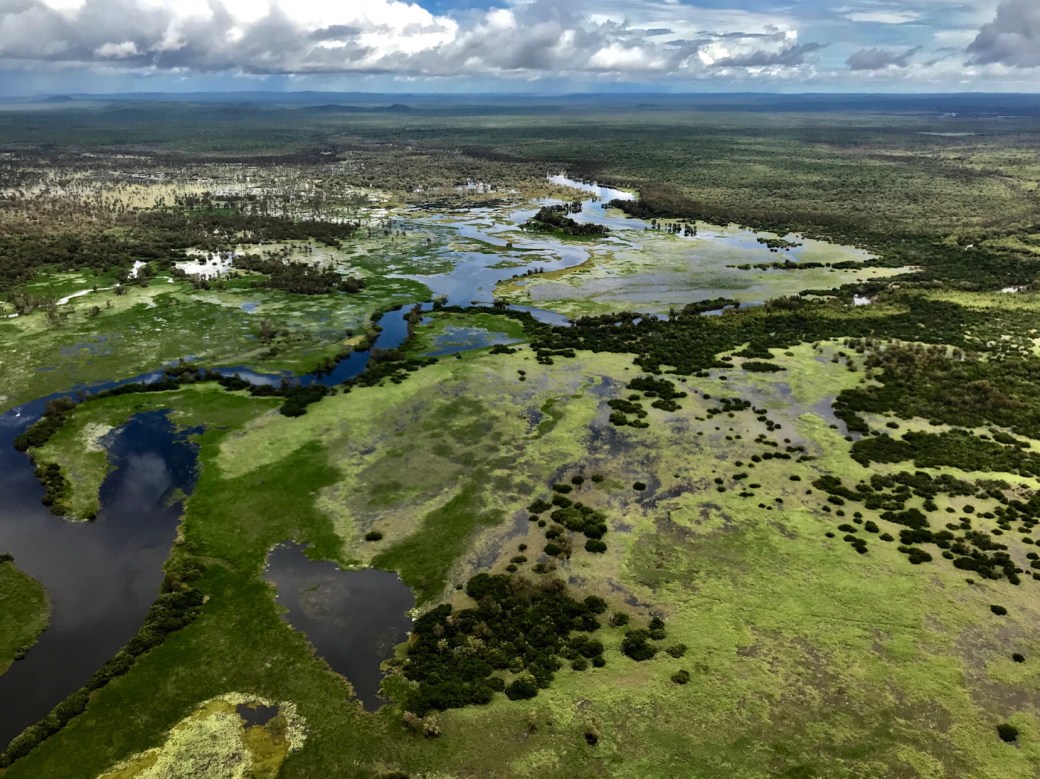 Getting off the plane, short ride to the lodge, handshake with the pilot, buy a cold drink from our favorite South African receptionist, before jumping into our car for the return ride to Darwin. We could not spend the last two days in Terra Australis any better.
Getting off the plane, short ride to the lodge, handshake with the pilot, buy a cold drink from our favorite South African receptionist, before jumping into our car for the return ride to Darwin. We could not spend the last two days in Terra Australis any better.

spectacular waterfalls.. flights are the best way to see it all
LikeLike
I knew there was a reason I never quite made it to Australia. Customer service sounds like the AlCan Highway and the climate atrocious. The scenery and aboriginal art were glorious, though. I have always been a fan of that art.
LikeLike
Breathtaking views of places I will never see. Thank you!
LikeLike